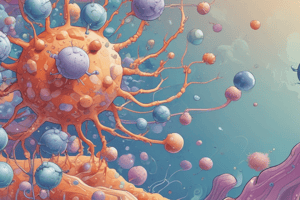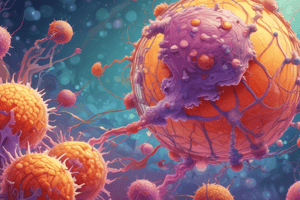Podcast
Questions and Answers
What is the role of B-1 cells in the immune system?
What is the role of B-1 cells in the immune system?
- They are important in adaptive immunity and require bone marrow for survival.
- They generate simpler, less adaptive immune responses with antibodies of low diversity. (correct)
- They produce high diversity antibodies that are highly specific.
- They solely develop in response to pathogenic infections.
What is a key characteristic of B cell positive selection?
What is a key characteristic of B cell positive selection?
- It occurs solely in the peripheral lymphoid tissues.
- B cells that bind strongly to self-antigens are positively selected.
- B cells that can weakly bind to self-antigens are positively selected. (correct)
- It ensures that only self-reactive B cells are allowed to mature.
Which statement best describes receptor editing in B cells?
Which statement best describes receptor editing in B cells?
- It strictly limits B cell maturation to only high-affinity clone production.
- It is a process exclusive to T cells in the thymus.
- It enhances the affinity of antibodies by editing their binding site.
- It allows B cells to change their receptors instead of undergoing apoptosis. (correct)
What happens to B cells that do not encounter their antigen?
What happens to B cells that do not encounter their antigen?
What is the main consequence of B cell negative selection?
What is the main consequence of B cell negative selection?
Where do B cells primarily undergo their development?
Where do B cells primarily undergo their development?
What describes the significance of a B cell binding a multivalent self-antigen?
What describes the significance of a B cell binding a multivalent self-antigen?
Which of the following best compares B1 and B2 cells?
Which of the following best compares B1 and B2 cells?
What defines the primary function of B-1 cells in the immune system?
What defines the primary function of B-1 cells in the immune system?
Which statement correctly describes the interaction between T cells and B cells during selection?
Which statement correctly describes the interaction between T cells and B cells during selection?
What occurs during receptor editing in B cells?
What occurs during receptor editing in B cells?
What is the result of the interaction between immature B cells and multivalent self antigens in the bone marrow?
What is the result of the interaction between immature B cells and multivalent self antigens in the bone marrow?
Which factor is critical for the activation of B-2 cells?
Which factor is critical for the activation of B-2 cells?
What is a major characteristic of plasma cells derived from activated B cells?
What is a major characteristic of plasma cells derived from activated B cells?
In the maturation process of B cells, what role does CXCL13 play?
In the maturation process of B cells, what role does CXCL13 play?
What happens to mature B cells that do not encounter their specific antigens within the lymph node?
What happens to mature B cells that do not encounter their specific antigens within the lymph node?
During B cell development, which phrase describes the main challenge for immature B cells in secondary lymphoid tissue?
During B cell development, which phrase describes the main challenge for immature B cells in secondary lymphoid tissue?
Why is the repertoire of B-2 cells considered vast?
Why is the repertoire of B-2 cells considered vast?
What type of antibody is primarily associated with natural antibodies originating from B-1 cells?
What type of antibody is primarily associated with natural antibodies originating from B-1 cells?
What characteristic differentiates B-cell memory from the primary response?
What characteristic differentiates B-cell memory from the primary response?
What occurs to self-reactive immature B cells that cannot modify their receptors through editing?
What occurs to self-reactive immature B cells that cannot modify their receptors through editing?
Flashcards are hidden until you start studying
Study Notes
B-1 Cells
- B-1 cells arise from the fetal liver by the 8th week of gestation.
- B-1 cells are crucial in innate immunity and autoimmune diseases.
- B-1 cells are likely transitional lymphocytes bridging the innate and adaptive immune systems.
- B-1 cells display slight immunologic memory, limited isotype switching, and a restricted repertoire.
- The B-1 cell repertoire is smaller than the repertoire of B-2 cells.
- B-1 cell receptors (BCRs) and antibodies often target conserved microbial antigens, such as lipopolysaccharide (LPS).
- B-1 cells are primarily found in tissues that serve as potential entry points for microbes, such as the peritoneal cavity and respiratory tract.
- B-1 cells can self-renew.
- Most, if not all, natural antibodies, like IgM antibodies directed against blood groups A and B (present without known immunization), are of B-1 origin.
B-2 Cells
- B-2 cells, also called conventional B cells, arise during and after the neonatal period.
- B-2 cells are widely distributed throughout lymphoid organs and tissues.
- B-2 cells are continuously replenished from the bone marrow throughout adulthood.
- B-2 cells require interaction with T cells for activation and proliferation.
- B-2 cells recognize a vast range of epitopes.
- Upon repeated antigen exposure, B-2 cells respond rapidly with increased antibody quantity and quality, often refining the affinity of the antibody produced (affinity maturation).
- B-2 cell responses frequently involve a change in immunoglobulin isotype (isotype switching).
- These characteristics are defining features of immunologic memory.
Phases of B-Cell Development
- Phase 1: Stem cell to Early Pro-B cell - Commitment to the B-cell lineage with expression of the transcription factor E2A.
- Phase 2: Early Pro-B cell to Late Pro-B cell - Heavy chain gene rearrangement begins.
- Phase 3: Large Pre-B cell to Small Pre-B cell - Successful heavy chain gene rearrangment, expression of the pre-B cell receptor.
- Phase 4: Immature B cell - Light chain gene rearrangement, expression of IgM on the cell surface.
- Phase 5: Mature B cell - Expression of both IgM and IgD on the cell surface.
- Phase 6: Plasma cell or Memory B cell - Antigen stimulation, differentiation into antibody-secreting plasma cells or long lived memory B cells.
B-Cell Negative Selection
- Immature B cells undergo negative selection in the bone marrow.
- B cells that strongly bind to self-antigens are eliminated.
- Negative selection is a crucial mechanism for preventing autoimmune diseases by eliminating self-reactive B cells.
Receptor Editing
- Immature B cells that recognize multivalent self-antigens in the bone marrow can undergo receptor editing.
- Receptor editing allows the B cell to continue rearranging its light-chain genes.
- This can delete the gene encoding the self-reactive light chain, providing a new light-chain arrangement and a B-cell receptor that no longer binds to the self-antigen.
- Receptor editing continues until a non-self-reactive receptor is produced or the B cell exhausts its supply of light-chain V or J gene segments.
- If a non-self-reactive light chain is generated, the B cell survives and continues its development.
- If a B cell runs out of rearrangements and remains self-reactive, it undergoes apoptosis.
- Receptor editing is a unique feature of B cells, not found in T cells.
B-Cell Maturation
- Immature B cells must pass through a primary follicle in a secondary lymphoid tissue to become mature B cells.
- Immature B cells enter the secondary lymphoid tissue via high endothelial venules (HEVs) attracted by chemokines CCL21 and CCL19.
- Immature and mature B cells compete to enter the primary follicle.
- Follicular dendritic cells (FDCs) secrete chemokine CXCL13, which attracts B cells into the follicle.
- Immature B cells entering the follicle interact with FDC-surface components, initiating the final stage of B-cell maturation.
- Immature B cells failing to enter a follicle continue recirculating but die.
- Mature B cells that do not encounter their specific antigens exit from the lymph node and recirculate through secondary lymphoid tissues via lymph and blood.
B-Cell Activation and Differentiation
- Mature naive B cells enter the lymph node via HEVs.
- In the T-cell area of the lymph node, B cells encounter antigen delivered in the afferent lymph draining from infected tissue.
- At the boundary between a lymphoid follicle and the T-cell area, the B cell is activated by a CD4 helper T cell to form a primary focus of dividing cells.
- Some activated B cells migrate to the medullary cords and differentiate into antibody-secreting plasma cells.
- Others migrate to a primary follicle and form a germinal center, where they further divide and differentiate.
- B cells from the germinal center migrate to the medullary cords or bone marrow to fully mature into plasma cells.
Studying That Suits You
Use AI to generate personalized quizzes and flashcards to suit your learning preferences.




